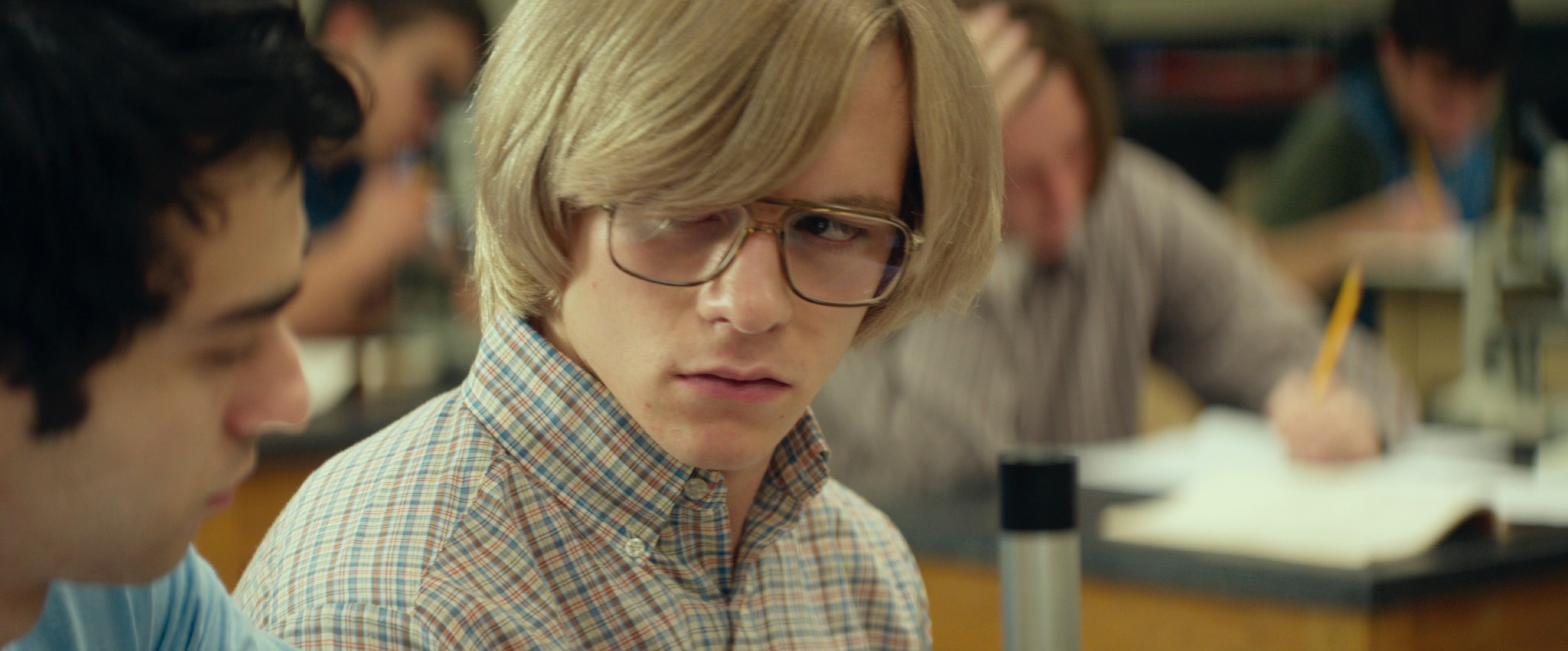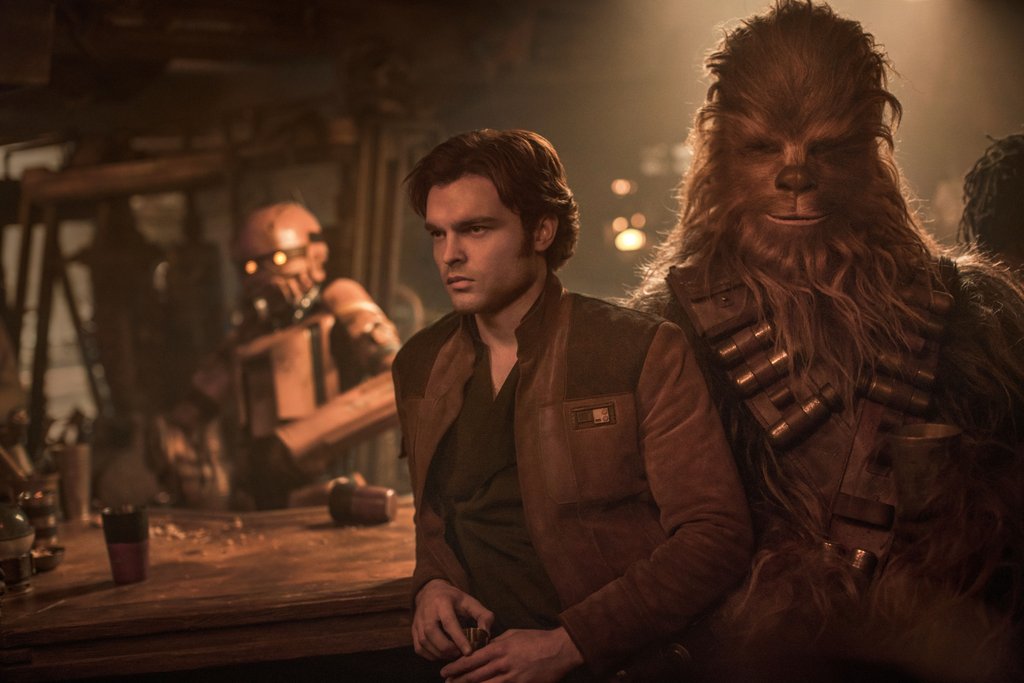Comparing Solo: A Star Wars Story and My Friend Dahmer
There are surprising parallels between Solo and indie drama My Friend Dahmer - and the former could have learned a trick from the latter...
This article comes from Den of Geek UK.
NB: The following contains spoilers for Solo: A Star Wars Story and The Force Awakens.
When Han sits down next to Chewbacca in the cockpit of the Millennium Falcon at the end of Solo: A Star Wars Story, the rising music and whine of engines hints at more exciting adventures to come. But at the same time, that final shot felt bittersweet, given the events of The Force Awakens; we already know that, decades hence, the galaxy’s most beloved smuggler will be killed by his own sociopathic son. Solo gives us a glimpse of Han’s formative years, but they’re colored by our knowledge of how ignominiously his story ends.
Coincidentally, some UK cinemas are currently running another movie where it’s events are colored by our knowledge of what happens next. Like Solo, indie drama My Friend Dahmer is a prequel of sorts, since it explores the high school years of Jeffrey Dahmer – one of America’s most infamous serial murderers.
Taking place in 1970s Ohio and based on the graphic novel by John “Derf” Backderf, My Friend Dahmer introduces Jeffrey as a troubled teenager – his alienation and increasingly alarming hobbies, and the warning signs that might, in any other scenario, have gone noticed by parents and teachers. Ross Lynch turns in a superb performance as Dahmer – detached, certainly, but also curiously sympathetic. It all starts with his awkward, shuffling gait – back hunched, arms rigidly by his sides, as though they’re being pulled to the ground by invisible weights. Then there’s the coldness around the eyes from behind his glasses, which seem to regard bullies and friends alike with the same quiet distrust.

My Friend Dahmer doesn’t flinch from showing its subject as an unknowable creature, and if there’s warmth in the movie – ably written and directed by Marc Meyers – it comes from Alex Wolff’s charismatic turn as John Backderf, the budding cartoonist who would later fictionalize his experiences in graphic novel form.
What makes My Friend Dahmer such a compelling and disturbing watch, though, is that the weight of future events hangs so heavily over every scene. Even though Dahmer’s fascination with dead animals might leave us reeling, we see how his upbringing might have conspired to turn him into the monster he’d soon become. His parents are well-meaning but completely absorbed in their own in-fighting and neuroses; his father (superbly played by Dallas Roberts) desperately wants Jeffrey to be ‘normal’ and fit in at school, but barely notices his increasing dependency on alcohol.
Jeffrey’s few friends treat him like a kind of living curiosity – a kook who gets attention by staging epileptic fits in school halls and busy shopping precincts. At first, Jeffrey’s antics make him a minor celebrity of sorts – at least until his deteriorating mental state pushes him still further into the shadows. My Friend Dahmer doesn’t offer any direct, smoking-gun answers about where its subject’s psychopathy came from – instead, it asks the same questions John Backderf likely asked himself years later. Most urgently: why did nobody see this coming? If someone had intervened, could Dahmer’s murderous path have been altered?
“None of us had seen Jeffrey since high school,” Backderf once recalled, thinking back to the time when he first heard that a former friend was now a convicted killer. “It was all very troubling and disorienting, as you can imagine. And as we sat around sharing stories, I heard some things I hadn’t heard before […]Now we had clarity, and suddenly these goofball tales had a new, utterly chilling meaning. And there were other stories that each of us had never shared, because they just seemed random or pointless. These too had new meanings, and suddenly they were worth telling. So I started writing stuff down in a sketchbook I had with me. I filled like 20 pages, and as I was doing so, I realised, wow, this is a great story.”
Like everyone else, Dahmer was a product of his environment; his difficult life at home, his torment by bullies at school. Somehow, in his teenage years, he began to conflate his fascination with dead animals with his homosexual fantasies. By the age of 18, Dahmer had already committed his first murder: a drifter named Steven Hicks. When Dahmer was arrested in 1991, he confessed to killing 17 people over the course of about 13 years.
My Friend Dahmer doesn’t show any of these murders, which only serves to make its drama more effective; as the credits roll, the overwhelming sensation is of sadness and frustration. If only Dahmer hadn’t slipped through the cracks; if only someone, for the sake of his victims, could have stopped him in time.

Much has been written about Solo: A Star Wars Story‘s disappointing ticket sales since its release in late May 2018. Was it, some have asked, because of its proximity to rival movies like Avengers: Infinity War and Deadpool 2? Was it because we’ve only had a major Star Wars release – The Last Jedi – within the past six months? Quite possibly. But we wonder whether there’s an additional, more subtle reason we could add to the pile: Disney-Lucasfilm hadn’t counted on how our knowledge of Han Solo’s future would cast a pall over a movie about his past.
At its best, Solo is a breezy thrill-ride – a kind of sci-fi Rake’s Progress about a young man who rapidly grows into the role of a cynical, risk-taking outlaw. Seeing how Han met his best friend Chewie and how he won the Millennium Falcon from Lando Calrissian are entertaining enough, but if you’re familiar with recent Star Wars lore (and you surely are if you’ve paid to see a Han Solo movie) then these moments could be seen as bittersweet, too. Solo: A Star Wars Story arrives at a point where it’s now clear which way the franchise is going. The Last Jedi effectively signalled the end of the Skywalker epoch with the low-key death of Luke; in the real world, Carrie Fisher’s passing means that Lucasfilm is rapidly running out of legacy characters to reintroduce.
Had Solo somehow come out before The Force Awakens – perhaps even as a final gasp from George Lucas before he retired – then maybe it would have been easier to take the heist antics of Ron Howard’s movie at face value. Instead, we’re poking about in the earlier years of a character whose story is already over; it’s nice to see how Han and Chewie met, but the image of Chewie wailing as Han fell to his death on the Star Killer base is still fresh in our minds. It’s pleasant to see Han grin as he gets the keys to the Millennium Falcon, but we’re also armed with the knowledge that, in the current mainline series, the ship now partly belongs to Rey.
Neither does Solo – as written by Lawrence and Jake Kasdan – attempt to square the daredevil cynicism of its hero with his inevitable fate. We see how Solo‘s years as a street urchin on Corellia see him ping-pong from a brief stint as an Imperial officer to the life of a thief. We see how he falls into the orbit of hardened criminal Tobias Beckett (Woody Harrelson, as casually charismatic as always) and how his life’s path diverges from that of his first love, Qi’ra (Emilia Clarke).
Unlike My Friend Dahmer, however, Solo never imparts a wrenching sense of who Han could have been if an alternate path had been open to him. In essence, Han was already a petty criminal from the beginning; it just took a few nudges to turn it into a viable career. The life of an Imperial officer might have been more secure in terms of long term prospects, but then again, the movie roundly depicts Han’s experiences in that role as roundly dreadful, and previous Star Wars films have already proved that most people who side with the Empire don’t typically last for long. In his position, we probably would have joined Beckett’s crew, too.
In My Friend Dahmer, we occasionally see glimpses of who this twisted, lost soul at its centre might have become in different circumstances: at one stage, he expresses an apparently sincere interest in becoming a biologist. At the very least, we could imagine a teacher or parental figure recognising his growing mental illness and addressing it before it was too late.
Solo: A Star Wars Story needn’t have been as heavy on the dramatics as an indie movie about a future serial killer, but it might have benefited from interrogating its central character with a similarly sharp eye. Solo zeroes in on the positive things that Han gains from his life as a rogue – Chewie, the Millennium Falcon – and Qi’ra provides the stand-in for what he’s lost. But we never get the sense of what frightens Han, his regrets, his fears, his doubts. In short, we see little of the attributes that might turn an archetype into a recognizable human being.
This is due in part to the writing, but also because so much weight has been put on making Solo into a typical summer blockbuster. If you believe the reports, Lucasfilm spent anywhere north of $250 million on Solo – a sum partially spent on those much-publicised reshoots, no doubt, but mostly blown on its big, expensive heist and flying sequences.
Ironically, Solo probably didn’t need big action sequences in the same way that a mainline Star Wars sequel or even a self-described war movie like Rogue One did. Indeed, it might have been a stronger film if it had been led more by its characters than its plot. As fun as the Solo movie we got is, we can’t help wishing there was an alternate version: a cheaper, less bombastic story that kicked back and spent more time with Han and explored who he was. Sure, he has the Millennium Falcon, but did he ever wish he just had an ordinary house somewhere? Is he afraid that his high-stakes lifestyle will one day catch up with him? What do he and Chewie talk about when they’re not in crisis mode?
My Friend Dahmer takes an infamous, horrifying figure from recent American history and, without excusing what he did, turns his teenage years into an absorbing and disturbing drama. Had Solo: A Star Wars Story taken a similar track – albeit within the context of a mainstream movie – it could have given the archetypal rogue a more human, heart-wrenching dimension.